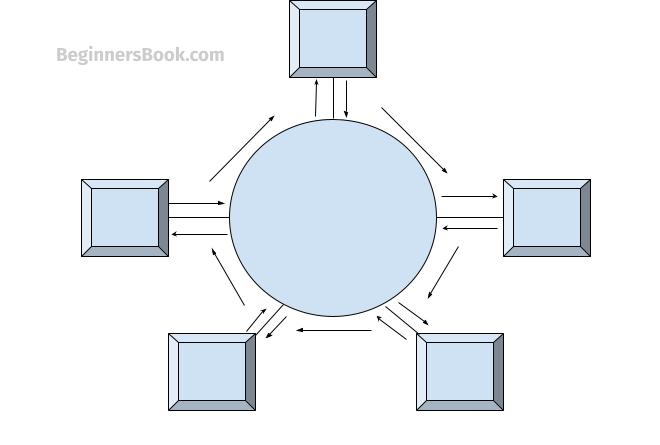What is Ring Topology – Advantages and Disadvantages
A geometrical representation of devices that are connected in a circular manner is called Ring topology. Each device in the ring topology is connected to immediate neighbour devices on both sides. A network that follows the ring topology is often referred as ring network.

In ring topology, data travels in a direction, passing from one device to another until it reaches its destination.
Cable used: RJ-45 cable or coaxial cable based on the network card used in the the devices.
Suitable for: Ring topology works on both LANs and WANs
History: Ring topology used to be preferred by small networks such as small building, school etc. It is not frequently used now a days because there are better alternatives available that provide better performance such as Star Topology.
Refer this guide to learn all about topologies: Types of Computer network topologies.
Mục Lục
Types of Ring topology:
There are two types of ring topologies:
1. Unidirectional Ring topology
Data flows in a single direction either clockwise or anti-clockwise.

2. Bi-directional Ring Topology
Data can travel in both the directions clockwise and anti-clockwise. This has an advantage over uni-directional ring topology, in case of a device failure, it can send data using other direction to still maintain the connectivity.
Applications of Ring topology
Uses of Ring topology are:
- Small school and collage can utilize the ring topology.
- In Local Area Networks when there is a need of uni-directional data flow. For example, a computer and a printer connected in a ring topology. Computer sends the data to printer, printer prints the data and sends acknowledgement.
- It can also be used in Wide area networks but in such cases it is better to use bi-directional ring topology as failure of one device can fail entire network, the bi-directional ring topology at least provides an alternative path of communication.
- SONET(Synchronous Optical Network) networks as data path is uni-directional.
Bidirectional
Advantages of Ring Topology
- Data collision is rare: Data collision doesn’t happen often in this topology because data flows in one direction.
- Speed: The data transfer speed is high in this topology networks.
- No Server: There is no concept of server like star and Tree Topology. In this topology only devices are connected to form ring network.
Disadvantages of Ring Topology
- Slower than other alternatives: Although speed is good in ring networks, it is still comparatively slower than other computer topologies such as Star topology. This is because in star topology, data directly transfers to other device passing through hub. In ring topology, data passes to each device on the network and then reaches destination.
- One device failure affect entire network: Since all devices are connected in circular manner, failure of one device in the network can break the path of all the data packets that are sent by other devices, this can shut down the communication of entire network.
- Expensive Hardware: Hardware to connect devices to the ring network is expensive compared to other topologies.
FAQ
Is ring topology active or passive?
Ring topology is an active topology because a signal passes through all the devices in the network.
What are the two types of ring topology?
There are two types of Ring topology: Uni-directional and Bi-directional. In uni-directional, data flows in a single direction while in bi-directional, data flows in both the directions. Bi-directional ring topology is more robust than uni-directional as it can still work in case of a device failure.
What is ring network in simple words?
Ring network is a network of devices connected in a circular manner. Each device has exactly two neighbours, You can visualize it as kids holdings hands with each other and forming a ring in the ground.















![Toni Kroos là ai? [ sự thật về tiểu sử đầy đủ Toni Kroos ]](https://evbn.org/wp-content/uploads/New-Project-6635-1671934592.jpg)


